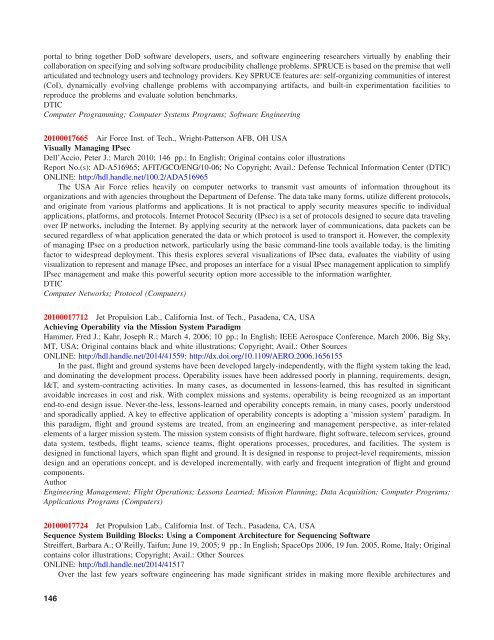NASA Scientific and Technical Aerospace Reports - The University ...
NASA Scientific and Technical Aerospace Reports - The University ...
NASA Scientific and Technical Aerospace Reports - The University ...
You also want an ePaper? Increase the reach of your titles
YUMPU automatically turns print PDFs into web optimized ePapers that Google loves.
portal to bring together DoD software developers, users, <strong>and</strong> software engineering researchers virtually by enabling their<br />
collaboration on specifying <strong>and</strong> solving software producibility challenge problems. SPRUCE is based on the premise that well<br />
articulated <strong>and</strong> technology users <strong>and</strong> technology providers. Key SPRUCE features are: self-organizing communities of interest<br />
(CoI), dynamically evolving challenge problems with accompanying artifacts, <strong>and</strong> built-in experimentation facilities to<br />
reproduce the problems <strong>and</strong> evaluate solution benchmarks.<br />
DTIC<br />
Computer Programming; Computer Systems Programs; Software Engineering<br />
20100017665 Air Force Inst. of Tech., Wright-Patterson AFB, OH USA<br />
Visually Managing IPsec<br />
Dell’Accio, Peter J.; March 2010; 146 pp.; In English; Original contains color illustrations<br />
Report No.(s): AD-A516965; AFIT/GCO/ENG/10-06; No Copyright; Avail.: Defense <strong>Technical</strong> Information Center (DTIC)<br />
ONLINE: http://hdl.h<strong>and</strong>le.net/100.2/ADA516965<br />
<strong>The</strong> USA Air Force relies heavily on computer networks to transmit vast amounts of information throughout its<br />
organizations <strong>and</strong> with agencies throughout the Department of Defense. <strong>The</strong> data take many forms, utilize different protocols,<br />
<strong>and</strong> originate from various platforms <strong>and</strong> applications. It is not practical to apply security measures specific to individual<br />
applications, platforms, <strong>and</strong> protocols. Internet Protocol Security (IPsec) is a set of protocols designed to secure data traveling<br />
over IP networks, including the Internet. By applying security at the network layer of communications, data packets can be<br />
secured regardless of what application generated the data or which protocol is used to transport it. However, the complexity<br />
of managing IPsec on a production network, particularly using the basic comm<strong>and</strong>-line tools available today, is the limiting<br />
factor to widespread deployment. This thesis explores several visualizations of IPsec data, evaluates the viability of using<br />
visualization to represent <strong>and</strong> manage IPsec, <strong>and</strong> proposes an interface for a visual IPsec management application to simplify<br />
IPsec management <strong>and</strong> make this powerful security option more accessible to the information warfighter.<br />
DTIC<br />
Computer Networks; Protocol (Computers)<br />
20100017712 Jet Propulsion Lab., California Inst. of Tech., Pasadena, CA, USA<br />
Achieving Operability via the Mission System Paradigm<br />
Hammer, Fred J.; Kahr, Joseph R.; March 4, 2006; 10 pp.; In English; IEEE <strong>Aerospace</strong> Conference, March 2006, Big Sky,<br />
MT, USA; Original contains black <strong>and</strong> white illustrations; Copyright; Avail.: Other Sources<br />
ONLINE: http://hdl.h<strong>and</strong>le.net/2014/41559; http://dx.doi.org/10.1109/AERO.2006.1656155<br />
In the past, flight <strong>and</strong> ground systems have been developed largely-independently, with the flight system taking the lead,<br />
<strong>and</strong> dominating the development process. Operability issues have been addressed poorly in planning, requirements, design,<br />
I&T, <strong>and</strong> system-contracting activities. In many cases, as documented in lessons-learned, this has resulted in significant<br />
avoidable increases in cost <strong>and</strong> risk. With complex missions <strong>and</strong> systems, operability is being recognized as an important<br />
end-to-end design issue. Never-the-less, lessons-learned <strong>and</strong> operability concepts remain, in many cases, poorly understood<br />
<strong>and</strong> sporadically applied. A key to effective application of operability concepts is adopting a ‘mission system’ paradigm. In<br />
this paradigm, flight <strong>and</strong> ground systems are treated, from an engineering <strong>and</strong> management perspective, as inter-related<br />
elements of a larger mission system. <strong>The</strong> mission system consists of flight hardware, flight software, telecom services, ground<br />
data system, testbeds, flight teams, science teams, flight operations processes, procedures, <strong>and</strong> facilities. <strong>The</strong> system is<br />
designed in functional layers, which span flight <strong>and</strong> ground. It is designed in response to project-level requirements, mission<br />
design <strong>and</strong> an operations concept, <strong>and</strong> is developed incrementally, with early <strong>and</strong> frequent integration of flight <strong>and</strong> ground<br />
components.<br />
Author<br />
Engineering Management; Flight Operations; Lessons Learned; Mission Planning; Data Acquisition; Computer Programs;<br />
Applications Programs (Computers)<br />
20100017724 Jet Propulsion Lab., California Inst. of Tech., Pasadena, CA, USA<br />
Sequence System Building Blocks: Using a Component Architecture for Sequencing Software<br />
Streiffert, Barbara A.; O’Reilly, Taifun; June 19, 2005; 9 pp.; In English; SpaceOps 2006, 19 Jun. 2005, Rome, Italy; Original<br />
contains color illustrations; Copyright; Avail.: Other Sources<br />
ONLINE: http://hdl.h<strong>and</strong>le.net/2014/41517<br />
Over the last few years software engineering has made significant strides in making more flexible architectures <strong>and</strong><br />
146

















